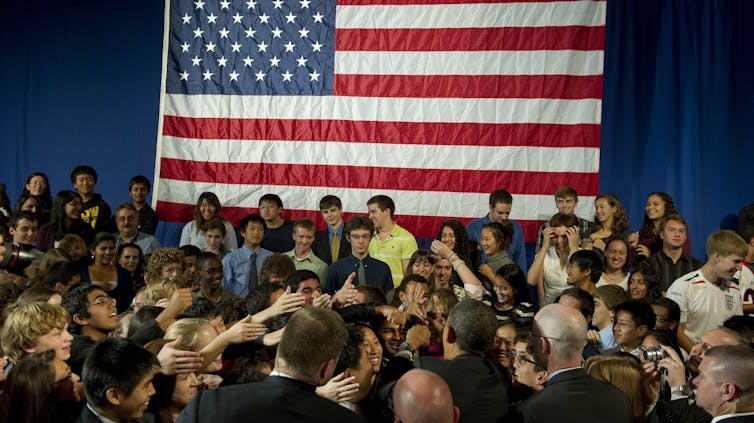An elite Virginia high school overhauled admissions for gifted students – here's how to tell if the
Gifted education has long faced accusations of being elitist and excluding students of color. Will new changes prepare more students for elite colleges, or will they water down current curriculums?

For decades, gifted education and talent development services in public schools have been accused of creating inequities for students of color, students from low-income communities and nonnative English speakers. This year, there seems to be remarkable momentum to change some systems.
Some changes defy common sense. In Virginia, the city of Charlottesville sought to address the equity issue by identifying virtually all students as gifted. However, the “gifted” label is no longer connected to any changes to instruction. California is seeking to improve equity in math education by blocking students from taking advanced courses like calculus or statistics before their junior year, ostensibly to focus resources on ensuring all students reach those courses. And New York City dropped its exam for 4-year-olds in favor of teachers’ nominating students they believe are gifted, a practice known to be affected by bias.
Thomas Jefferson High School for Science and Technology – a magnet school in Fairfax, Virginia, that U.S. News & World Report ranks as the top public high school in the country – is one school making changes that are supported by educational research. The school faced criticism from parents, the community and activists for having a student body that is about 70% Asian while the Fairfax district student population as a whole is about 20% Asian. In response, and after extensive debate, the school overhauled its admissions process this year.
As an education researcher who studies how testing can be used to identify academic potential in students from all backgrounds, I can say that some of the changes the Fairfax high school made are backed by evidence. As such, they will likely lead to more students from underrepresented groups completing challenging courses that prepare them for elite colleges.
But whatever the results are, I believe this experiment is an important opportunity for the entire field of gifted education. It will help those interested in creating equitable educational opportunities learn what changes can support greater academic success for more students.
What was changed
First, Thomas Jefferson High School for Science and Technology increased its freshman class by about 15% – allowing 70 additional students to enroll. Gifted elementary and high school programs, just like elite universities in the U.S., are more selective than they need to be. Elite colleges routinely reject students with near-perfect test scores who clearly have demonstrated the ability to succeed in academics.
The second important change is that the school district increased its outreach. This allowed more families to know about the opportunities provided by the school program and how to apply. Researchers have shown that, in highly competitive gifted admissions, insider knowledge is an advantage wealthier parents often have. It helps them optimize their children’s chances of selection.
Third, the high school reduced obstacles to applying, including the $100 application fee and teacher nomination requirements. Other districts may create obstacles by scheduling admissions tests outside of school hours or requiring parents to opt in for consideration rather than having students automatically considered. Not all caregivers are equally able to arrange transportation or understand the information sent home from schools.
And finally, the school dedicated seats to students who had GPAs in the top 1.5% of each middle school in the district. Gifted education research has demonstrated the importance of recognizing that students who perform far above their same-school peers require a more rigorous curriculum.

Lessons for other schools
Some parents at Thomas Jefferson argued that these changes will lower achievement scores or leave fewer graduates prepared for elite STEM college programs. They are also concerned that teachers will need to water down the curriculum to allow students to succeed.
I suspect the new freshman class will have equivalent or greater success without substantial changes to the curriculum. However, even if the curriculum is adjusted substantially, these changes will help those engaged in education learn more about nurturing academic talent in all students.
One possible outcome is that teachers stick with the standard curriculum and students perform just as well or even better. In other words, no unusual changes are needed for the new cohort of students to maintain similar GPAs, degree completion and admission to selective colleges. This outcome would suggest that the school had been more selective than it needed to be. It should encourage other school systems to expand gifted programs and decrease the pressure on families to compete for scarce seats.
A second possible outcome is that students are less successful with the standard curriculum. If that happens, I would not conclude that the experiment was a failure, but rather that this particular curriculum didn’t work for students who come from communities that have been historically marginalized in schools. The admissions process at Thomas Jefferson and similar schools may need to reinstate some of the selection measures that effectively identified successful students in the past.
Equitable access does not require that every school reduce its rigor if some students don’t succeed. The solution may be to expand other kinds of programs to increase student preparation. One potential solution would be creating bridge programs similar to those designed to prepare students for college. Bridge programs can provide accelerated instruction or remediation of skills before a student starts an advanced program.
And finally, the new cohort of students may be successful only with substantial adjustments to the curriculum. This outcome would demonstrate that educators have found effective adaptations to help students from marginalized communities succeed. Again, this suggests adding new programs that serve different levels of academic readiness.
[3 media outlets, 1 religion newsletter. Get stories from The Conversation, AP and RNS.]
Documenting successes
A 2021 lawsuit brought by a coalition of “concerned parents” contends that the changes at Thomas Jefferson are illegal and are intended to reduce the number of Asian students. The percentage of Asian students dropped from 73% to 54% under the new system. This decrease in access for Asian students is another consequence of keeping programs needlessly scarce.
No change to the selection process for gifted programs will resolve what I feel is the underlying issue – systemic racism that prevents students from marginalized communities from receiving the same quality of education provided to better-resourced communities. And changes to admission policies won’t necessarily create a culturally responsive curriculum or inclusive school environment that can improve student success.
As schools engage in these experiments with gifted education and talent development programs, documenting students’ successes and obstacles will help gifted education educators, parents and others learn how to improve education for all students.
Joni Lakin receives research funding from the Institute of Education Sciences, National Science Foundation, and the Office of Naval Research. She is affiliated with Riverside Insights as a test author.
Read These Next
From truce in the trenches to cocktails at the consulate: How Christmas diplomacy seeks to exploit s
World leaders like to talk up peace at Christmastime. But alongside the tales of seasonal breaks in…
As DOJ begins to release Epstein files, his many victims deserve more attention than the powerful me
Powerful men connected to Jeffrey Epstein are named, dissected and speculated about. The survivors,…
How to reduce gift-giving stress with your kids – a child psychologist’s tips for making magic and a
Depending on family circumstances and a child’s personality type, gift giving runs the gamut of fun…






